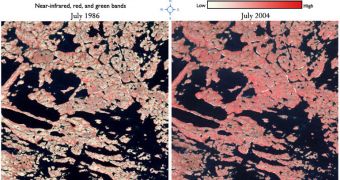The results of a 20-year study indicate that the amount and range of shrubs and grasses has increased considerably in northern Quebec, Canada. This expansion was primarily triggered by a warming climate. The study highlights just one of the negative aspects of global warming.
Data used to arrive at these conclusions were collected from Landsat satellites, which are operated jointly by NASA and the US Geological Survey (USGS). This series of missions has been going on for decades, and provide high-resolution, continuous data coverage of particular areas.
Climate experts have been warning that this will happen for several years now, but they never had access to sufficiently-relevant datasets to actually confirm their proposals. Now, the Landsat missions finally demonstrate what experts have known all along.
Full details of the study will be presented at the fall meeting of the American Geophysical Union (AGU) today, December 9. The conference is held in San Francisco, California. The lead author of the research is NASA Goddard Space Flight Center (GSFC) expert Jeff Masek.
“For the first time, we've been able to map this change in detail, and it's because of the spatial resolution and length-of-record that you can get with Landsat,” says the Landsat program scientist.
“Unlike the decline of sea ice, which is a dramatic effect that we're seeing as a result of global warming, the changes in vegetation have been subtle,” he explains. This is why datasets covering this issue need to be extensive, covering large stretches of time.
The study also clears an apparent mystery that climate researchers have been trying to break. It related to the fact that computer models proposed a northward expansion of vegetation throughout this century.
Simulations “predict a dramatic change over the next 100 years, and people have been wondering why we weren't seeing these changes already,” Masek says. Apparently, the change was not yet visible because insufficient studies had documented it. This issue has now been resolved.
Other factors that influence plant range include the availability of water and sunlight, the type of terrain on which they grow, the number of competitors they have in their ecosystems, the amount of space they have access to, as well as the resources present.
“The warm temperatures are only part of the equation,” concludes GSFC expert and principal study investigator, Doug Morton.

 14 DAY TRIAL //
14 DAY TRIAL //